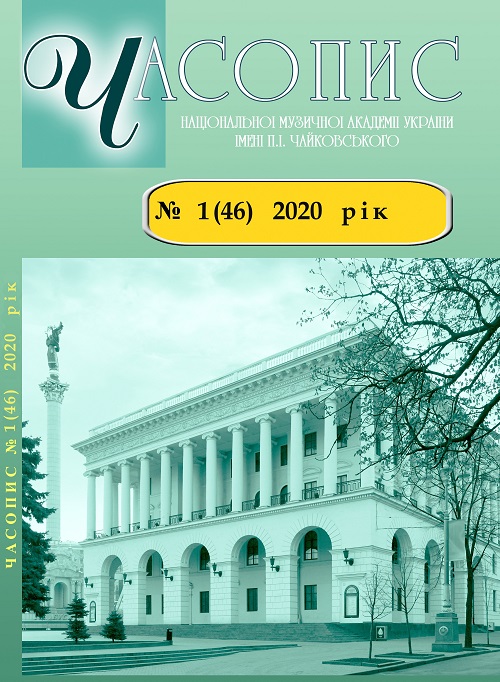Скрипковий Концерт Ігоря Стравінського: інноваційна модель темброво-акустичної взаємодії соліста і оркестру
DOI:
https://doi.org/10.31318/2414-052x.1(46).2020.198515Ключові слова:
творчість І. Стравінського, інструментування, тембр, композиторська інтерпретація, інструментальний концерт, соліст, оркестрАнотація
Розглянуто своєрідне трактування у концертно-симфонічній творчості І. Стравінського тембру, фактури, форми у співвідношенні «соліст — оркестр». У центрі дослідження перебуває інструментування, як засіб вибудовування композитором тембрового втілення форми в авторській моделі темброво-акустичної взаємодії соліста та оркестру. Аналіз «роботи з моделями» в Концерті для скрипки з оркестром І. Стравінського, з цього погляду, надає можливість виявити значення інтерпретаційного потенціалу тембру, що у ХХ столітті суттєво розширюється завдяки удосконаленню інструментарію і виконавських технік. Дослідження унікальної спадщини І. Стравінського, зокрема Концерту для скрипки з оркестром, надасть змогу усвідомити роль тембру як інтерпретаційного чинника, тобто виявити, завдяки яким тембровим засобам композитор втілює свої творчі методи («робота з моделлю», «варіації на стиль», «полістилістику») й винаходить свою інноваційну версію темброво-акустичної взаємодії соліста та оркестру і на яких засадах вона закріплюється. Як потужний засіб композиторської інтерпретації, інструментування є для І. Стравінського одним із шляхів роботи над стилістикою. Палітра тембрових засобів виразності, відповідних музичному матеріалу сприяє створенню бароково-класичного забарвлення, та водночас, і перешкоджає цьому, коли композитору потрібно відійти від титульної тематики. «Рухлива» стилістика спонукає посилювати функціональність тембру і фактури в авторській моделі темброво-акустичної взаємодії соліста й оркестру. Створення її нової, інноваційної версії передбачає перегляд І. Стравінським певних засад інструментування. Для характеристики цього феномена у творчості композитора обрано Першу частину його скрипкового Концерту (1931)Завантаження
Посилання
Banschikov, G. (2003). Laws of the functional instrumentation [Zakony funktsionalnoy instrumentovki], the manual. Saint-Petersburg: Kompozitor, 236 p. [in Russian].
Bila, K. (2011). Genre-style model of instrumental concert and conceptual foundations of the composer’s interpretation on the example of works by L. M. Kolodub [Zhanrovo-stylova model instrumentalnoho kontsertu ta kontseptsiini zasady kompozytorskoi interpretatsii na prykladi tvoriv L. M. Koloduba]. The dissertation author’s abstract for gaining the degree of the Candidate of Art Criticism by specialty 17.00.03 Music Art. National Musical Academy of Ukraine. Kyiv, 20 p. [in Ukrainian].
Bobrovskiy, V. (1977). The functional basics of the musical form [Funkcional'nye osnovy Muzykalnoy formy] the research. Moskow: Muzyka, 332 p. [in Russian].
Borisenko, M. (2005). Genre of the transcription in the system of composer’s individual style [Zhanr transkriptsii v sisteme individualnogo kompozitorskogo stilya]. The dissertation author’s abstract for gaining the degree of the Candidate of Art Criticism by specialty 17.00.03 Music Art. Kharkiv National Kotlyarevsky University of Arts. Kharkiv, 195 p. [in Russian].
Glivinskiy, V. (1989). Elements of the baroque stylistics in the I. F. Stravinsky art [Elementy stilistiki barokko v tvorchestve I. F. Stravinskogo]. The dissertation author’s abstract for gaining the degree of the Candidate of Art Criticism by specialty 17.00.02 Music Art. N. A. Rimsky-Korsakov Leningrad Order of Lenin State Conservatoire. Leningrad, 13 p. [in Russian].
Grebneva, I. (1991). Genre of the violin concert in the foreign European music 1920th–1930th [Zhanr skripichnogo kontserta v zarubezhnoy evropeyskoy muzyke 1920–1930-h godov]. The dissertation author’s abstract for gaining the degree of the Candidate of Art Criticism by specialty 17.00.02 Music Art. Tchaikovsky Moscow State Conservatory. Moskow, 25 p. [in Russian].
Grebneva, I. (2011). The violin concerto in the European music of 20th century [Skripichnyj kontsert v evropejskoj muzyke XX veka]. The dissertation author's abstract for gaining the degree of the Doctor of Art Criticism by specialty 17.00.02 Music Art. Tchaikovsky Moscow State Conservatory. Moskow, 41 p. [in Russian].
Druskin, M. (2009). Igor Stravinsky. Personality, oeuvre, views [Igor Stravinkiy. Lichnost, tvorchestvo, vzglyady]. Druskin, M. Collected works [Sobranie sochineniy], in 7 vol., vol. 4. Saint-Petersburg: Kompozitor, pp. 31–285 [in Russian].
Zharkov, A. (2011). The timbre syntax in the aspect of the cultural traditions interaction [Tembrovyj sintaksis v aspekte vzaimodejstvija kul'turnyh tradicij]. Kyiv Musicology [Kyivske muzykoznavstvo]. Issue 37. Kyiv, pp. 49–64 [in Russian].
Moskalenko, V. (2012). Lectures about the musical interpretation [Lektsii po Muzykalnoy interpretatsii: uchebnoe posobie], the tutorial. Kyiv: Klyaksa. 272 p. [in Russian].
Palij, I. (2012). The transduction as a phenomenon of the musical culture (on the examples of the piano cycle by M. Mussorgsky “Pictures at an Exhibition” and the art of rock groups of King Krimson and Pink Floyd) [Transduktsiia yak yavyshche muzychnoi kultury (na prykladi fortepiannoho tsyklu M. Musorhskoho «Kartynky z vystavky» i tvorchosti rok-hurtiv King Krimson ta Pink Floyd)]: abstract. The dissertation author’s abstract for gaining the degree of the Candidate of Art Criticism by specialty 17.00.03 Music Art. Kharkiv National Kotlyarevsky University of Arts. Kharkiv, 16 p. [in Ukrainian].
Piston, W. (1990). Orchestration [Orkestrovka], transl. from English by K. Ivanova. Moskow: Sovetskij kompozitor. 459 p. [in Russian].
Ponomaryov, S. (2011). For the problems of interconnection of the timbre and the form [K probleme vzaimosvyazi tembra i formy v Muzykalnom proizvedenii]. The dissertation author’s abstract for gaining the degree of the Candidate of Art Criticism by specialty 17.00.02 Music Art. Tchaikovsky Moscow State Conservatory. 31 p. [in Russian].
Savenko, S. (1977). About the Stravinsky’s neoclassicism [O neoklassitsizme Stravinskogo]. Problems of the music of 20th century [Problemy muzyyki XX veka]. Gorkiy: VolgoVyatskoe knizhnoe izdatelstvo, pp. 179–210. [in Russian].
Savenko, S. (2001). The world of Stravinsky [Mir Stravinskogo], the monograph. Moskow: Kompozitor. 355 p. [in Russian].
Serebryanskaya, A. (2012). The timbre intonating as a musical aspect [Tembrovoe pereintonirovanie kak problema muzykoznanija]. Problems of the interaction of art, pedagogic and theory and practice of education [Problemy vzaiemodii mystetstva, pedahohiky ta teorii i praktyky osvity]. Issue 34. Kharkiv: S. A. M., pp. 251–258 [in Russian].
Skrypnyk, L. (2009). Specifications of the investigation of principles of dialogue and play in violin concerts of 20th century [Spetsyfika vyiavlennia pryntsypiv dialohu ta hry u skrypkovykh kontseptsiiakh XX stolittia]. The dissertation author’s abstract for gaining the degree of the Candidate of Art Criticism by specialty 17.00.03 Music Art. Tchaikovsky National Music Academy of Ukraine. Kyiv, 17 p. [in Ukrainian].
Stravinsky, I. (1971). About own works [O svoih proizvedenijah]. Stravinsky, I. Dialogues. Remembrances. Thinking. Commentaries [Dialogi. Vospominanija. Razmyshlenija. Kommentarii], transl. from English by V. Linnik. Leningrad: Muzyka, pp. 136–214 [in Russian].
Stravinsky, I. (1988). The modern musical perception [Sovremennoe muzikalnoe vospiyatie]. Stravinsky, I. Publicist and interlocutor [Publitsist i sobesednik], compiled by V. Varunts. Moskow: Sovetskij kompozitor, pp. 102–105 [in Russian].
Stravinsky, I. (2012). Musical poetics [Muzykalnaya poetika]. Stravinsky, I. Chronics. Poetics [Hronika. Poetika], compiled by S. Levit, I. Osinovskaya. Moskow, Saint-Petersburg: Tsentr Gumanitarnyh Initsiativ, pp. 171–274 [in Russian].
Tukova, I. (2011). Traktovka zvuka yak faktor formuvannia tekhniky suchasnoi kompozytsii. Journal of the Tchaikovsky National Music Academy of Ukraine [Chasopys Natsionalnoi muzychnoi akademii Ukrainy imeni P. I. Chaikovskoho]. Issue 1 (10). Kyiv, pp. 72–79 [in Ukrainian].
Holopova, V. (2001). Forms of musical pieces [Formy muzykal'nykh proizvedeniy], the tutorial, 2nd ed. Saint-Petersburg: Lan, 496 p. [in Russian].
Khutorska, A. (2009). Composer's interpretation of a poetic text as an artistic translation (analyzed on the material of chamber-vocal music) [Kompozytorska interpretatsiia poetychnoho tekstu yak khudozhnii pereklad (na prykladi kamerno-vokalnoi muzyky)]. The dissertation author’s abstract for gaining the degree of the Candidate of Art Criticism by specialty 17.00.03 Music Art. Kharkiv State Kotlyarevsky University of Arts. Kharkiv, 17 p. [in Ukrainian].
Shnittke, A. (1973). The paradoxicalness as a feature of Stravinsky’s musical logic [Paradoksal'nost' kak cherta muzykal'noy logiki Stravinskogo]. Igor Stravinsky. Articles and materials [Igor' Stravinskij. Stat'i i materialy]. Moskow: Muzyka, pp. 383–434 [in Russian].
Shnittke, A. (1994). Polystylistical tendencies in the modern music [Polistilisticheskie tendencii v sovremennoj muzyke]. Conversations with Alfred Shnittke [Besedy s Al'fredom Shnitke], compiled by A. Ivaksin. Moskow: RIK Kultura, pp. 143–146 [in Russian].
Yarustovskiy, B. (1969). Igor Stravinsky. The short essay on life and work [Igor Stravinskiy. Kratkij ocherk zhizni i tvorchestva], the monograph, 2nd ed. Moskow: Sovetskij kompozitor. 319 p. [in Russian].
Stravinsky, I. (1931). Concerto en Ré for Violin and Orchestra. London: Ernst Eulenburg Ltd. 64 p. [in English].
White, E. (1979). Stravinsky. The composer and his works. Berkeley and Los Angeles: California University Press. 651 p. [in English].
##submission.downloads##
Опубліковано
Як цитувати
Номер
Розділ
Ліцензія
Починаючи з червня 2025 року авторське право на публікацію залишається за авторами.
Автори можуть використовувати власні матеріали в інших виданнях за умови посилання на журнал «Часопис Національної музичної академії України імені П. І. Чайковського» як на місце першої публікації.
Наш журнал дотримується авторських прав та дозволів CREATIVE COMMONS для журналів із відкритим доступом.
Автори, які публікуються в цьому журналі, погоджуються з такими умовами:
- автори лишають за собою право на авторство своєї роботи та передають журналу право першої публікації цієї роботи на умовах ліцензії Creative Commons Attribution-ShareAlike 4.0 International License, яка дає змогу іншим особам вільно поширювати опубліковане дослідження з обов'язковим посиланням на авторів оригінальної роботи та першу публікацію роботи в цьому журналі;
- автори мають право укладати самостійні додаткові угоди щодо неексклюзивного розповсюдження роботи такою, якою її було опубліковано цим журналом (наприклад, розміщувати роботу в електронному сховищі установи або публікувати у складі монографії), за умови збереження посилання на першу публікацію роботи в цьому журналі.




